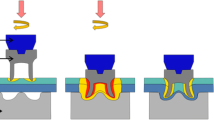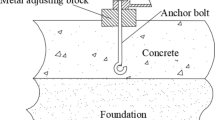Abstract
The thermal performance of a steel-basalt fiber polymer concrete machine tool joint surface has a key influence on a machine tool. Based on virtual material theory, the equivalent thermal model was established and the thermal performance parameters of virtual materials were deduced by theoretical calculation. The calculation method of actual contact area ratio of steel — basalt fiber polymer concrete joint surface was established based on discrete principle and its accuracy was verified. To determine the influence of preload pressure on the actual contact area ratio, a prediction model was established. The thermal conductivity of the material was measured by the quasi-steady state method. A new systematic simulation analysis method that synthesizes virtual material theory and finite element simulation analysis was proposed, and its accuracy was verified. The results show that the relative error is only 5.01%, which proves the method’s effectiveness.
Similar content being viewed by others
Abbreviations
- h c :
-
Equivalent thermal contact conductance
- δ c :
-
Virtual material equivalent thickness
- λ s, λ g, δ v :
-
Steel, BFPC and air medium thermal conductivities
- k c, k v :
-
Actual contact area ratio of solid material and air medium
- A c, A n :
-
Actual contact area and nominal contact area
- R c :
-
Thermal resistance
- ρ c :
-
Virtual material equivalent density
- ρ s, ρ b, ρ v :
-
Steel, BFPC and air medium densities
- V :
-
Volume of the virtual material
- V s, V b :
-
Steel specimen and BFPC specimen rough surface layer volumes
- m s, m g :
-
Steel specimen and BFPC specimen rough surface layer masses
- m v :
-
Air medium mass
- Cs, Cg, C v :
-
Steel, BFPC and air medium specific heat capacities
- L :
-
Contact rubbing greyscale image side length
- N :
-
Aliquots number
- Na :
-
Contact units number
- N i :
-
Internal contact units number
- N b :
-
Boundary contact units number
- Nb1 :
-
Boundary contact units number of inside the picture
- N b2 :
-
Picture edge contact units number
- S :
-
Boundary contact units contact area
- \(\overline S \) :
-
Average contact area of the boundary contact unit
- κ :
-
Contact area ratio coefficient
- A′c :
-
Discretized contact area
- k′c :
-
Discretized contact area ratio
- P :
-
Pressure preload
- t :
-
Time
- T :
-
Temperature
- β :
-
Thermal diffusivity
- Lh :
-
BFPC specimen thickness
- q :
-
Heat flux
- U :
-
Heating voltage
- RR :
-
Heating resistance
References
Y. Chang, J. Ding, Z. He, A. Shehzad and Y. Chen, Effect of joint interfacial contact stiffness on structural dynamics of ultra-precision machine tool, International J. of Machine Tools and Manufacture, 158 (2020) 103609.
K. K. Singh, V. Kartik and R. Singh, Modeling of dynamic instability via segmented cutting coefficients and chatter onset detection in high-speed micromilling of Ti6Al4V, J. of Manufacturing Science and Engineering, 139 (2017) 051005.
H. Sugishita, H. Nishiyama, O. Nagayasu, T. Shin-Nou and M. O-Hori, Development of concrete machining center and identification of the dynamic and the thermal structural behavior, CIRP Annals, 37 (1988) 377–380.
H. C. Möhring, C. Brecher, E. Abele, J. Fleischer and F. Bleicher, Materials in machine tool structures, CIRP Annals, 64 (2015) 725–748.
D. S. Jung and G. L. Dai, Design and manufacture of hybrid polymer concrete bed for high-speed CNC milling machine, International J. of Mechanics and Materials in Design, 4 (2008) 113–121.
H. S. Kim and K. Y. Park, A study on the epoxy resin concrete for the ultra-precision machine tool bed, J. of Materials Processing Technology, 48(1–4) (1995) 649–655.
J. X. Shen, P. Xu and Y. H. Yu, Dynamic characteristics analysis and finite element simulation of steel-BFPC machine tool joint surface, J. of Manufacturing Science and Engineering, 142 (2020) 011006.
Z. Liu, K. Jiang, C. Zhang and Y. Tian, A stiffness model of a joint surface with inclination based on fractal theory, Precision Engineering, 62 (2020) 47–61.
R. Wang, L. Zhu and C. Zhu, Research on fractal model of normal contact stiffness for mechanical joint considering asperity interaction, International J. of Mechanical Sciences, 134 (2017) 357–369.
H. Ye, Y. Huang, P. Y. Li, Y. Li and L. Bai, Virtual material parameter acquisition based on the basic characteristics of the bolt joint interfaces, Tribology International, 95 (2016) 109–117.
Y. Q. Wen, J. Y. Tang, W. Zhou, L. Li and C. C. Zhu, New analytical model of elastic-plastic contact for three dimensional rough surfaces considering interaction of asperities, Friction, 10 (2022) 217–231.
A. Majumdar and B. Bhushan, Fractal model of elastic-plastic contact between rough surfaces, J. of Tribology, 113 (1991) 1–11.
Y. R. Jeng and S. R. Peng, Elastic-plastic contact behavior considering asperity interactions for surfaces with various height distributions, J. of Tribology, 128 (2005) 245–251.
S. Wang and K. Komvopoulos, A fractal theory of the interfacial temperature distribution in the slow sliding regime: Part I-elastic contact and heat transfer analysis, J. of Tribology, 116 (1994) 812–822.
M. Q. Zou, B. M. Yu, J. C. Cai and P. Xu, Fractal model for thermal contact conductance, J. of Heat Transfer, 130(10) (2008) 101301–1–10130–9.
C. V. Madhusudana, Thermal Contact Conductance, Springer New York, NY (1996).
W. L. Gu and Y. S. Yang, The influence of temperature on contact resistance of metallic surfaces temperature, J. of Nanjing University of Aeronautics and Astronautics, 26 (1994) 342–350.
J. L. Liu, C. Ma, S. L. Wang, S. B. Wang, B. Yang and H. Shi, Thermal-structure interaction characteristics of a high-speed spindle-bearing system, International J. of Machine Tools and Manufacture, 137 (2019) 42–57.
V. A. Yastrebov, G. Anciaux and J. F. Molinari, On the accurate computation of the true contact-area in mechanical contact of random rough surfaces, Tribology International, 114 (2017) 161–171.
Acknowledgments
The present work is supported by National Natural Science Foundation of China (52005238), National Natural Science Foundation of China (51375219), Education Department of Liaoning Province (LJ2019JL030), Doctor Initiation Fund of Science and Technology Department of Liaoning Province (2020-BS-256).
Author information
Authors and Affiliations
Corresponding author
Additional information
Jiaxing Shen is an Associate Professor at Research Institute of Technology and Equipment for the Exploitation and Utilization of Mineral Resources, Liaoning Technical University. He received his Ph.D. from Liaoning Technical University in 2018. His main work includes mechanical system dynamics analysis and control, mechanical joint surface performance analysis, etc.
Zihao Pan is a postgraduate student at Liaoning Technical University. His research interests include dynamic analysis and control of mechanical systems and thermodynamics of mechanical joint surface.
Ping Xu is a Professor of Mechanical Engineering, Liaoning Technical University. He received his Ph.D. from Liaoning Technical University in 2006. His main work includes mechanical system dynamics analysis and control, advanced manufacturing technology and systems.
Yinghua Yu is a Professor of Mechanical Engineering, Liaoning Technical University. She received her Ph.D. from Liaoning Technical University in 2007. Her main work includes mechanical system dynamics analysis and control, advanced manufacturing technology and systems.
Rights and permissions
About this article
Cite this article
Shen, J., Pan, Z., Xu, P. et al. Theoretical modelling and simulation analysis of the thermal performance of a steel-basalt fiber polymer concrete machine tool joint surface. J Mech Sci Technol 36, 3753–3765 (2022). https://doi.org/10.1007/s12206-022-0648-y
Received:
Revised:
Accepted:
Published:
Issue Date:
DOI: https://doi.org/10.1007/s12206-022-0648-y




